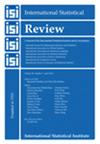物联网时间序列的在线证据最近邻分类
IF 1.8
3区 数学
Q1 STATISTICS & PROBABILITY
引用次数: 0
摘要
本文章由计算机程序翻译,如有差异,请以英文原文为准。
Online Evidential Nearest Neighbour Classification for Internet of Things Time Series
The ‘Internet of Things’ (IoT) is a rapidly developing set of technologies that leverages large numbers of networked sensors, to relay data in an online fashion. Typically, knowledge of the sensor environment is incomplete and subject to changes over time. There is a need to employ classification algorithms to understand the data. We first review of existing time series classification (TSC) approaches, with emphasis on the well‐known k‐nearest neighbours (kNN) methods. We extend these to dynamical kNN classifiers, and discuss their shortcomings for handling the inherent uncertainty in IoT data. We next review evidential kNN ( EkNN ) classifiers that leverage the well‐known Dempster–Shafer theory to allow principled uncertainty quantification. We develop a dynamic EkNN approach for classifying IoT streams via algorithms that use evidential theoretic pattern rejection rules for (i) classifying incoming patterns into a set of oracle classes, (ii) automatically pruning ambiguously labelled patterns such as aberrant streams (due to malfunctioning sensors, say), and (iii) identifying novel classes that may emerge in new subsequences over time. While these methods have wide applicability in many domains, we illustrate the dynamic kNN and EkNN approaches for classifying a large, noisy IoT time series dataset from an insurance firm.
求助全文
通过发布文献求助,成功后即可免费获取论文全文。
去求助
来源期刊

International Statistical Review
数学-统计学与概率论
CiteScore
4.30
自引率
5.00%
发文量
52
审稿时长
>12 weeks
期刊介绍:
International Statistical Review is the flagship journal of the International Statistical Institute (ISI) and of its family of Associations. It publishes papers of broad and general interest in statistics and probability. The term Review is to be interpreted broadly. The types of papers that are suitable for publication include (but are not limited to) the following: reviews/surveys of significant developments in theory, methodology, statistical computing and graphics, statistical education, and application areas; tutorials on important topics; expository papers on emerging areas of research or application; papers describing new developments and/or challenges in relevant areas; papers addressing foundational issues; papers on the history of statistics and probability; white papers on topics of importance to the profession or society; and historical assessment of seminal papers in the field and their impact.
 求助内容:
求助内容: 应助结果提醒方式:
应助结果提醒方式:


